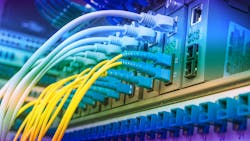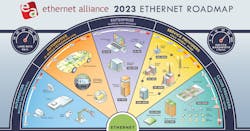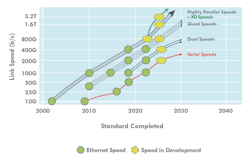Ethernet at 50: Exploring Its Past, Present, and Future
This article is part of Electronic Design's 70th Anniversary series. Also check out The Voices of Ethernet video series.
What you’ll learn:
- A look at Ethernet through the years.
- The importance of interoperability as Ethernet technology continues to evolve.
Ethernet is the backbone of our connected world and 2023 marks the 50th anniversary of this pervasive technology. The efficiency and resiliency of Ethernet makes it applicable to a broad set of applications, increasing the importance of interoperability.
One overarching tenet of the Ethernet Alliance’s mission is the proliferation of interoperability for the wide range of devices, interconnect solutions, and data rates within the Ethernet ecosystem. The basic network components haven’t really changed; with each advancement of speed, we’re still testing switches, systems, and network interface cards (NICs) connected with cables and optical modules.
However—and under the covers, so to speak—there’s been an explosion of applications centered on, and anchored by, Ethernet’s communications frameworks.
Ethernet Then
Ethernet began life as a 10-Mb/s communication channel, which was considered quite fast as the throughput offered significant headroom for the compute requirements of the time. In the mid-1990s, Ethernet expanded to 100 Mb/s, opening the door to new applications, higher density storage devices, and the burgeoning world wide web. Companies like Novell and Banyan created complete end-to-end systems, sidestepping many interoperability challenges.
In contrast to other serial communication protocols like USB and PCIe, Ethernet isn’t constrained to a specific architecture or interface. The technology is open to many interpretations, implementations, and applications. Yet, fast-forward 30 years and interoperability challenges have become even more complex with multiple data rates, diverse connection interfaces, and abundant new applications competing for compute time.
The pace at which Ethernet speeds are defined and ratified, as well as the multiple signaling and interface options, have changed dramatically, too. In a little over 20 years, the data rate for Ethernet installations has moved beyond 10 Gb/s to more than 40 0Gb/s. Ethernet is now transiting twisted-pair cabling in both the 4-pair category and single pair, along with twinaxial cabling and optical networks, just to name a few of today’s different interconnect options.
The days of all-inclusive network systems providers have given way to the specialization of products supporting pieces of the entire ecosystem. Seamless operation of data centers and user applications, accompanied by the dramatic rise in speeds, mandates the entire Ethernet community to continue its investment in ensuring long-term interoperability.
Ethernet Now
Ethernet is the underpinning of the internet and the catalyst of the ongoing IoT explosion, finding a home in countless automotive, industrial, consumer, business, military, and commercial applications. Self-driving cars and connected roadway applications rely on Ethernet for communications. Connected household appliances, like refrigerators, now inform their owners that they’re out of milk or eggs, or the lint filter in the dryer needs attention. Factory-floor automation, HVAC systems, and building controls are traveling over single-pair Ethernet connections.
Beyond facilitating autonomous driving, automotive Ethernet is not only augmenting, but soon may replace legacy in-car infotainment, control, and communications systems. The ubiquity of Ethernet supports consolidation of the disparate CAN, SPI, and other interconnections into one common serial communications protocol.
Ethernet’s low-cost, low-weight single-pair variants were first standardized in 2016 at 100-Mb/s and 1-Gb/s speeds. Today, the automotive Ethernet ecosystem is filled out at each Ethernet speed from 10 Mb/s to 25 Gb/s. But just as Ethernet connections to laser printers and end-stations grew to encompass all kinds of computing, the connectivity developed for automotive Ethernet is now evolving to connect industrial equipment.
More recently, it has expanded its reach into building automation, moving at slower speeds but longer lengths, with 10BASE-T1L links spanning hundreds of meters on single-pair wiring. This expansion continues with IEEE 802.3da and IEEE 802.3dg Task Force members already working on ways to move forward with room-spanning multidrop 10-Mb/s links and building-spanning 100-Mb/s links as the applications grow.
In addition, advances in Power over Ethernet (PoE) specifications allow for intelligent power distribution in a wide array of applications. PoE shipments in the past two decades have totaled more than a billion ports, making it the de facto powering choice for wired IoT, telephony, and security applications.
Factory floors and office spaces alike benefit when both data and power are supplied over Ethernet premise wiring. It reduces expenditures by consolidating cabling and operational costs via granular power and energy management.
And ensuring interoperability in PoE is a challenge faced by the industry. The Ethernet Alliance’s PoE Certification Program seeks to bring clarity and assurance to the growing PoE global market.
Ethernet in the Future
Ethernet technology continues to evolve at lightspeed, with advances driven by applications across a broad spectrum, and at every level of speed and function.
At the high end of speed range, the individuals donating their time, energy, and intellect in the IEEE 802.3 Ethernet (standards) Working Group to define the bits and bytes of Ethernet completed specifications work for 100-Gb/lane electrical signaling just last year. The Ethernet ecosystem is now beginning to ship products and solutions based on this 100-GbE standard.
However, the hottest discussion topic in the hallways at IEEE and tradeshow aisles this year is all about 200-Gb/lane signaling. The need for speed is clear and gated only by the laws of physics and tolerance for the cost to connect.
The evolution of lane speeds is accompanied by the number of lanes that may be consolidated in a single connector footprint. The adoption of the Octal Small Form Factor Pluggable (OSFP), and the Quad Small Form Factor Pluggable Double Density (QSFP-DD), interfaces are defined to consolidate eight individual data lanes into a single port.
As of this writing, the definition of the OSFP Extra Density (OSFP-XD) connection is being framed to allow 16 individual data lanes to occupy a single, high-density port on the next generation of network switches and routers.
Conclusion
The myriad of applications benefiting from Ethernet technology is seemingly boundless, and therefore likely unlimited. With each subsequent Ethernet Alliance Plugfest or interoperability demonstration, we see products and applications evolving to incorporate more features and capabilities because of Ethernet communications.
Cars and trucks will replace existing control systems with Ethernet communications and become the foundation for tomorrow’s connected highways. Consumer and industrial devices will receive both data and power over the Ethernet premise wiring, making the connected home the norm rather than the exception. Commercial and military aircraft will rely more on Ethernet signaling for fly-by-wire controls and other avionics.
That list will continue to grow, as there appears to be no ceiling for applications suited to the benefits of Ethernet. Here’s to 50 more years of Ethernet.
This article was also authored with Ethernet Alliance leadership contributions from Orshi Abraham (Spirent), Peter Jones (Cisco), and George Zimmerman (CME Consulting).
Read more articles in Electronic Design's 70th Anniversary series.
About the Author
Chris Lyon
President, Ethernet Alliance
Chris Lyon is president of the Ethernet Alliance. He is the Cloud Business Development Manager for the Americas at Amphenol CS.


